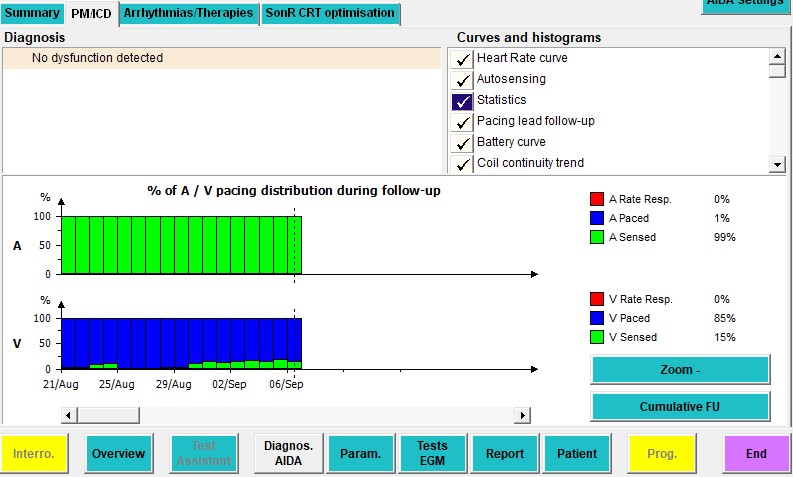Drop in percentage CRT
Case Summary
0 of 1 Questions completed
Questions:
Information
You have already completed the case before. Hence you can not start it again.
Case is loading…
You must sign in or sign up to start the case.
You must first complete the following:
Results
Results
Time has elapsed
Catégories
- Pas classé 0%
-
Device interrogation is essential in order to guide to the correct diagnosis. Important aspects are to first exclude other causes of loss-of-CRT by confirming proper functioning of all leads, looking for AF/(NS)VT episodes in the memories and excluding fusion. These aspects will be shown and dicussed in the other cases in this course.
The “Zoom+” feature under PM/ICD Statistics clearly shows that there is 15% ventricular sensed events since the last few days. In the absence of AF or RV lead noise, this can only be due to intrinsic ventricular events. When there is no increase in ventricular heart rate, (non)sustained ventricular arrhythmia can also be excluded. Two possible causes remain: fusion with intrinsic conduction (AV delay programmed too long) and PVCs. Analysis of the ECG or EGM is important as it is the only way to distinguish between the two.
Premature ventricular extrasystoles are a common cause of loss of CRT. As the right ventricular lead senses a ventricular event before the end of the AV delay timer, left ventricular pacing is inefficient (to late for resynchronization) and is inhibited. PVCs are most often clearly visible on the ECG or EGM.
The final cardiac cycle is a PVC, inhibiting LV pacing and decreasing CRT%.
The sudden onset or increase of PVCs in a CRT patient may be due to external factors such as changes in electrolytes, increased filling pressures or ischemia. Most often a clear cause for the PVC burden is not identified and treatment is initiated aiming to decrease the surge in automaticity and restore percentage CRT to >90-95%. Beta-blockers are most commonly used to decrease PVC burden and only rarely invasive procedures (PVC ablation) are required to maintain high %CRT.
- 1
- Current
- Review / Skip
- Answered
- Exact
- Inexact
-
Question 1 of 1
1. Question
ExactInexact



